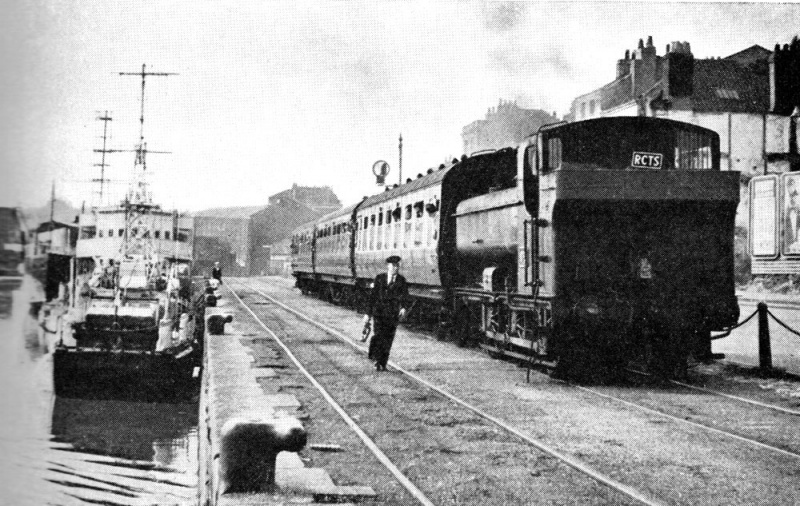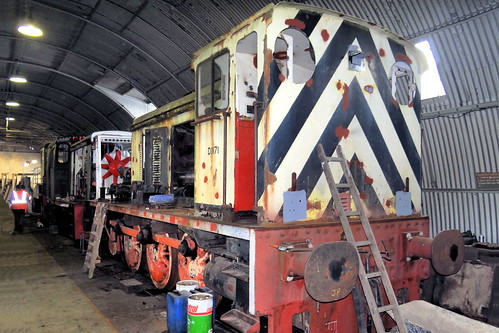Following up from the story of Portbury in Preservation, here are a few highlights from Henbury’s career after being withdrawn from Avonmouth shed in the 1960s.
Henbury was rebuilt with the 5 year old boiler from a sister engine, and in after a spell in store, in 1972 she was located at Radstock engine shed with No.242 and Portbury.

‘Henbury’s classmate, Peckett S12 ‘Clifton’ on shed at Avonmouth, (Photo copyright Geoff Plumb, used here with permission)

Henbury under restoration at Radstock in 1972 – note the striped bufferbeam typical of Avonmouth locos
She was put to work hauling brake van specials from Radstock Station to Writhlington – a distance of approximately 1.5 miles.
At this time she wore a partly lined out green livery (lining on the cabside and front of the saddletank only), lighter than the shade she had when withdrawn, with red buffer beams.

Henbury working on passenger trains at Radstock


As mentioned before, the Radstock operation finished in 1975 and Henbury was homeless for a short while, until in 1978, the Bristol Industrial Museum opened.

Henbury outside M Shed, before it opened as Bristol Industrial Museum, December 1975
Henbury was present at the opening ceremony of the museum, and was immediately put to work pulling passenger trains on the quayside.
At this time, coal trains from the main line would regularly travel down to Whapping Wharf sidings, either trip worked a BR loco, or thereafter by the Western Fuel Company’s Hudswell Clark shunter.
It was in 1981 that the diesel loco required repairs, the Western Fuel Co. turned to the nearby museum for assistance, and Henbury was pressed into service to keep coal coming in to Bristol, thereby becoming the first preserved steam loco to haul scheduled goods trains for British Rail.
Repainted with a yellow bunker, running plate and WESTERN FUEL CO. lettering on the tank sides, she pulled full wagons from Ashton Meadows to Whapping Wharf, and empties back, for two weeks.

On shuttle runs, 27/09/1981

At the old passenger halt, 27/09/1981

In Western Fuel Co. markings, ready to pull coal trains, 27/09/1981
The above photographs are copyright John Chalcraft and can be purchased from Railphotoprints

At the Wapping Wharf sidings, Fuel Co. compound to the right

Approaching the site of the current SS Great Britain Halt

On shuttle runs showing the yellow bunker
The above photos are copyright flickr user Emmdee

Sharing the line with an unusual stablemate

At the site of SS GB Halt
Above photos are copyright Robert Tarling
Henbury has hauled thousands of passengers over the years. In the 1990s her livery was altered again, the lining more closely resembles that which she wore at Avonmouth, but extending over the saddle tank as well as the cab.
Here she is pulling BR Mk1 carriages at the Festival of the Sea in 1996, before the main line link was severed.

Henbury in ex-works condition, 1996
Rob Skuse on the M Shed working exhibits page compiled a little selection of Henbury’s exploits over the past 10 years. These pictures are all copyright Rob Skuse.

Receiving some attention in the old workshops

With the refurbishment of M Shed under way, the power supply to the cranes was cut off. Henbury stepped in to help once more, and with the help of some chains, dragged the cranes into position

Ready to go

At the ‘Gromits Unleashed’ launch in 2013 with Aardman’s Nick Park.

On winter holiday at Midsomer Norton

Ready to attack the incline

In July 2014, she was withdrawn once more, and will be dismantled to allow her boiler to be inspected.

Photo courtesy of Juliet Eden




































